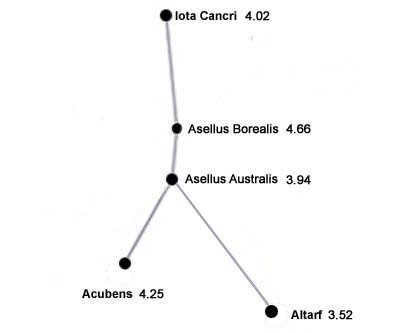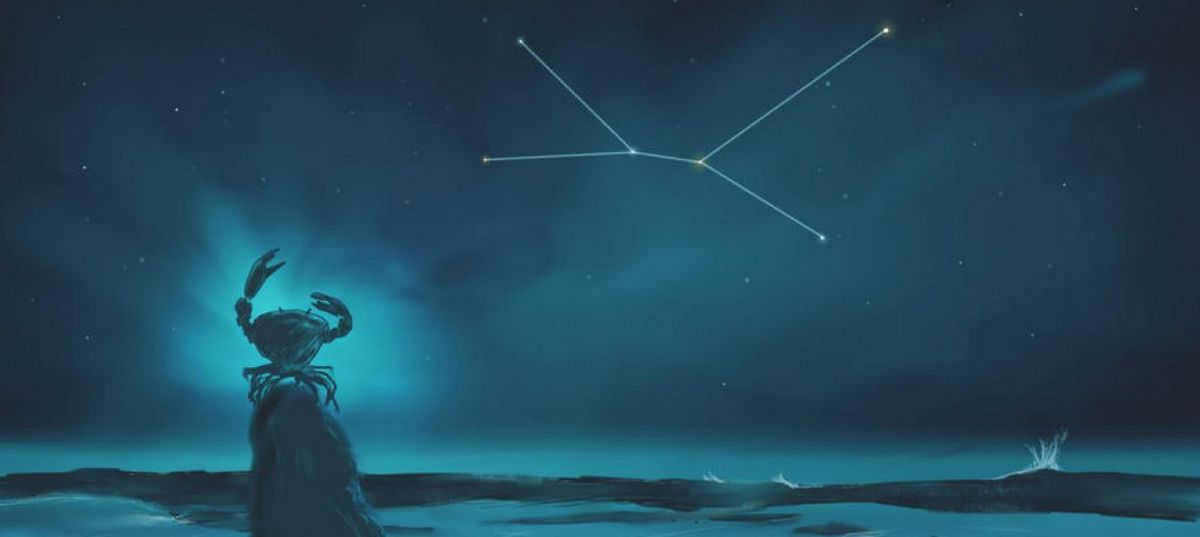
The constellation Cancer is not particularly notable in the night sky. While it may not stand out on its own, it holds significance as part of the zodiacal circle, positioned directly after Gemini. The unremarkable nature of the Cancer constellation stems from its dimness. Nevertheless, it covers a considerable area, spanning 506 square degrees.
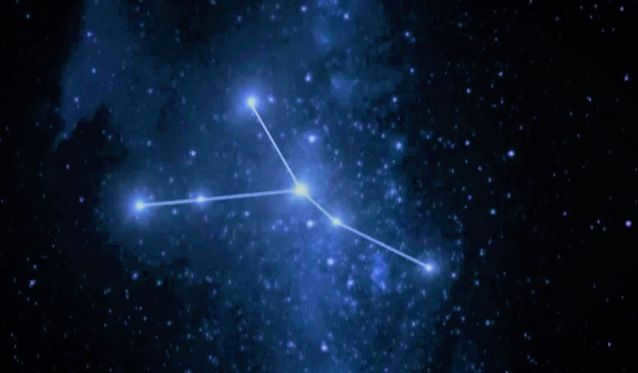
Legends and Folklore
Similar to the stories of many other constellations, the myth of Cancer originates from Greek mythology. According to this tale, the constellation came into existence after the defeat of the Hydra by Heracles. In an attempt to distract the hero from the battle, the goddess Hera sent Cancer, but he was swiftly crushed underfoot. In recognition of the animal’s bravery, Hera decided to immortalize it by placing it in the night sky as a constellation. Another version of the legend suggests that Heracles kicked the crayfish with such force that it was sent soaring into the heavens.
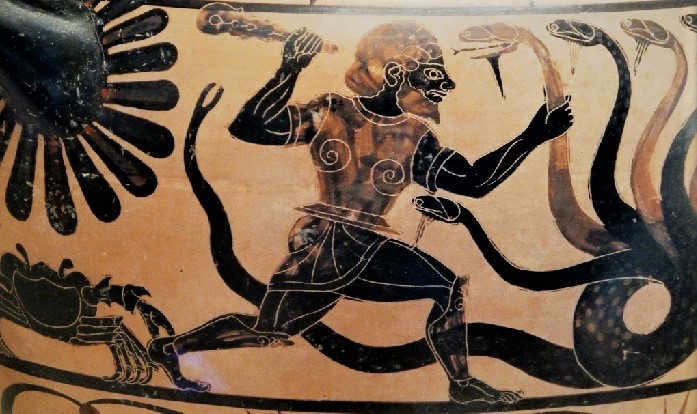
The stars in the constellation of Cancer
Interestingly enough, the primary star in Cancer is not even the brightest in the constellation. Acubensis, a double system meaning “claw,” is actually the fourth brightest among the others.
The brightest star in Cancer is Beta. It is also a double system known as Altarf, which means “the eye of the Lion.”
Another double star in the constellation is Delta. Azellus Australis, also known as the “Southern Donkey,” is composed of an orange giant and a smaller companion.
Gamma is one of the fascinating celestial bodies in the Cancer constellation. It is a triple star system comprised of a white subgiant and two accompanying satellites. This star system is commonly referred to as Azellus Borealis, also known as the “Northern Donkey.”
Epsilon of Cancer is another notable star in the Cancer constellation. It is a binary system called Meleph, similar to Gamma, as it consists of a white subgiant, but with only one companion. This star is a proud member of the Crèche cluster.
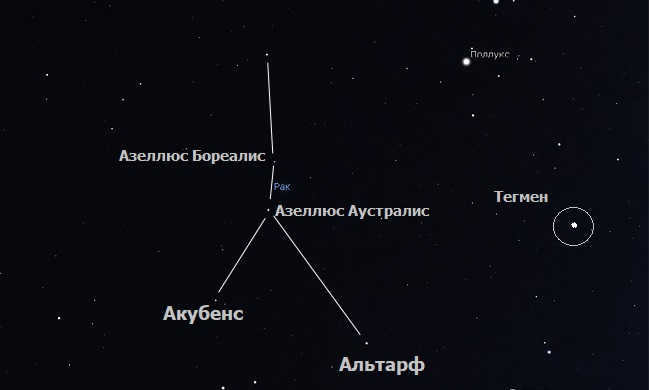
Zeta of Cancer is a multiple system called Tegmen, which is composed of five luminaries. Its size is so immense that it can be easily observed even without the aid of a telescope. However, only one star is visible to the naked eye, while the other components become apparent upon closer examination.
This Cancer star is classified as an orange giant and is three times more massive than our Sun.
Theta is another binary system located in the constellation of Cancer, consisting of an orange giant and its companion.
Iota is a double system, ranking ninth in the Bayer designation, yet it is the third brightest star in the Cancer constellation. It is informally known as Decapoda, meaning “ten-legged crustacean”.
Additional objects
Within the constellation of Cancer, there is a notable star cluster called the Crèche, which is also commonly referred to as the Beehive. This particular cluster stands out due to its impressive collection of over two hundred stars. Its proximity to our planet allows for easy visibility with the naked eye.
NGC 2682 is recognized as one of the oldest scattered clusters in the entire Universe. Scientists estimate its age to be between 3-5 billion years, and it boasts a population of over five hundred luminaries.
In addition to star clusters, there are also spiral galaxies present within the Cancer constellation. One notable example is NGC 2536, which experienced the eruption of the supernova SN 2014ds.
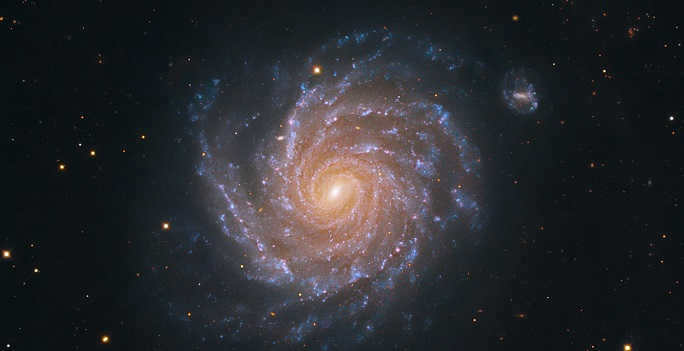
The Crab constellation is also known for its Donkey and Nursery asterism, which features the stars Azellus Australis and Azellus Borealis. This is how the constellation got its name. The asterism is also connected to an ancient Greek myth, where donkeys were responsible for carrying Dionysus through a treacherous swamp, leading to their placement in the heavens. It’s no wonder that the ancient Greeks recognized Donkeys and Manger as a distinct constellation.
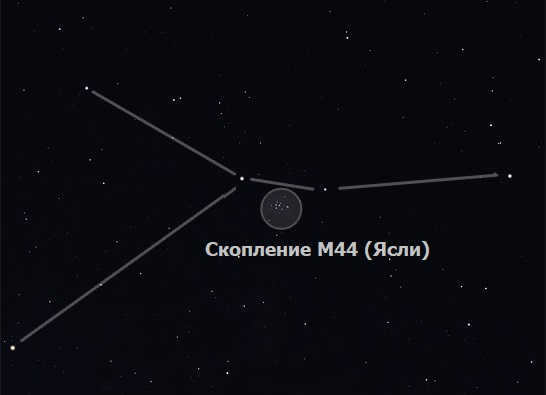
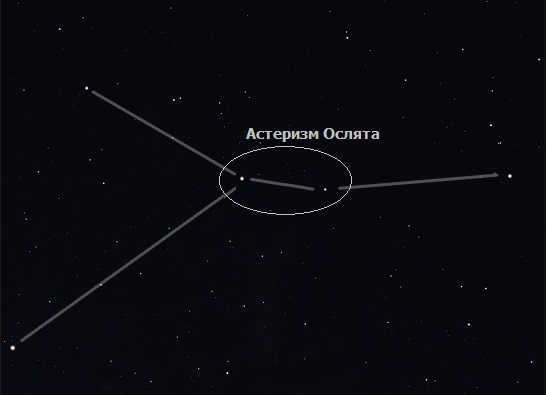


Did you know?
- The constellation known as Cancer has been recorded as early as in Ptolemy’s writings.
- Many people refer to the constellation Cancer as the Crab.
- The Tropics of Cancer, located in the northern tropical belt of the Earth, got its name because of the ancient belief that the summer solstice occurred in this area.
- 55 Cancer, also known as the Copernicus system, is home to a planet made up mostly of diamonds – 55 Cancer e.
Observation
The Sun travels through the Cancer constellation from July 21 to August 9, which means it cannot be observed during this period. However, it can be seen in latitudes ranging from +90 to -56 degrees across Russia for the rest of the year. The ideal time for observation is believed to be in January and February. Due to its faintness, Cancer can only be spotted on a clear night.
Cancer is a constellation situated in the northern sky. Its name originates from the Latin words “crayfish” or “crab”.
Out of the 12 zodiacal constellations (representing the 12 signs of the zodiac in astrology), Cancer is regarded as the least bright. Its symbol symbolizes water. The Greek astronomer Ptolemy first documented it in the second century.
The Cancer constellation is home to several well-known celestial objects, such as the open clusters Crèche (Messier 44), Messier 67, and the interacting spiral galaxies NGC 2535 and NGC 2536.
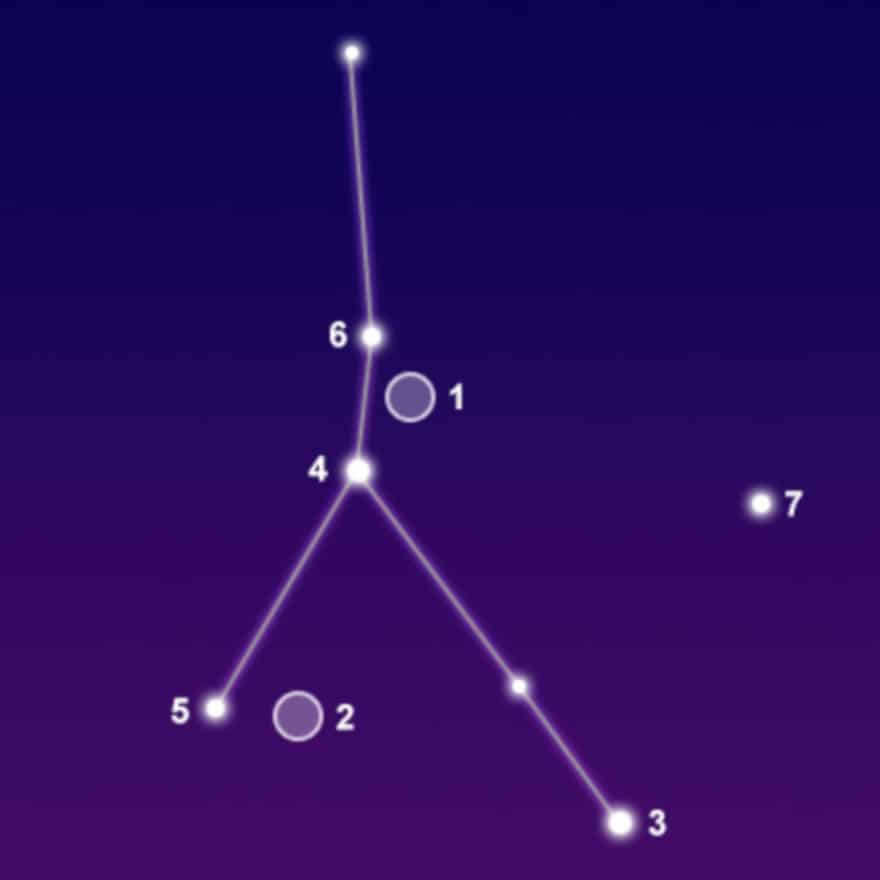
Facts, Position, and Map
When it comes to size, the zodiacal constellation of Cancer is ranked 31st, covering an area of 506 square degrees. It can be found in the second quadrant of the northern hemisphere (NQ2) and spans latitudes from +90° to -60°. In close proximity to Cancer are the constellations of Small Dog, Leo, Hydra, Gemini, Small Leo, and Lynx.
Cancer is home to two Messier objects: the Nursery cluster (M44, NGC 2632) and M67 (NGC 2682), as well as two stars known to have exoplanets. The brightest star in Cancer is Beta Cancer. Additionally, there is a meteor stream called Delta Cancrida. Cancer is part of the zodiacal group, which also includes Aries, Taurus, Gemini, Leo, Virgo, Libra, Scorpio, Sagittarius, Capricorn, Aquarius, and Pisces. To get a visual representation of the constellation Cancer, refer to a star map.
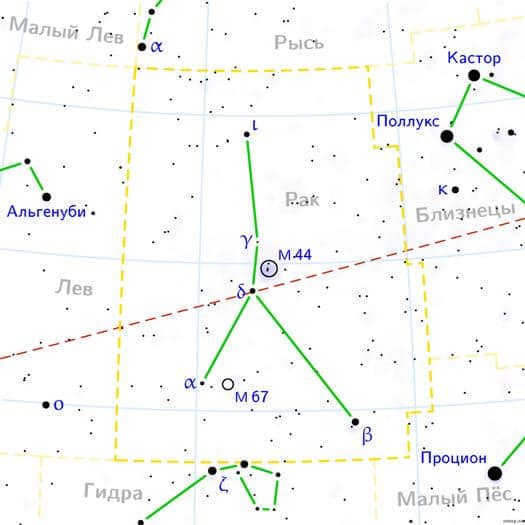

Legend
According to ancient Greek mythology, Cancer is connected to the story of Hercules and his 12 labors. During one of his tasks, Hercules had to face the formidable Lernaean Hydra, a creature with multiple heads and deadly breath. During the intense battle, Hera, the queen of the gods, sent a crab to distract Hercules. However, the hero swiftly kicked the crab into the sky, immortalizing it as the constellation Cancer.
There is an alternative version of the story, where Hercules simply stepped on the crab. In this version, Hera, impressed by Hercules’ strength and determination, decided to honor the crab by placing it among the stars. However, as Hercules ultimately failed in his task to defeat the Hydra, Hera also punished the crab by confining it to a region of the sky with dimmer stars.
Discover the magnificent stars of the Cancer constellation in the northern hemisphere through detailed descriptions and characterizations.
Alpha Cancer (Acubens) is an intriguing multiple star system located 174 light-years away. It falls under the spectral class A5m and boasts a luminosity that is 23 times greater than that of the Sun. This star holds the 4th brightest position within the constellation. Its apparent magnitude fluctuates between 4.20 and 4.27. Due to its proximity to the ecliptic, it can sometimes be obscured by the Moon and other planets. This particular star is occasionally referred to as Al-Zubāna (derived from the Arabic word az-zubānah, meaning “claws”) or Sertan (from the Arabic word saraţān, meaning “crab”).
The primary component of Alpha Cancer, known as Alpha Cancer A, is an intriguing white dwarf that belongs to the A-type main sequence. It has the potential to be a binary system, consisting of two stars separated by a mere 0.1 angular seconds. Additionally, this star possesses an 11th magnitude companion known as Alpha Cancer B.
Beta Cancer, also known as Altarf, is a binary star system consisting of an orange giant star of the K-type and a companion star with a magnitude of 14 at a distance of 29 arc seconds. It holds the top position in terms of brightness within the Cancer constellation, with a visual magnitude of 3.5. Altarf is located approximately 290 light-years away from Earth. The name Altarf originates from the Arabic words aṭ-ṭarf ‘eye’ or aṭ-ṭarfah ‘Lion’s eye’.
Delta Cancer, also referred to as Azellus Australis, is an orange giant star with an apparent stellar mass of 3.94. It is situated at a distance of 180 light-years. This star is the second brightest one in the Cancer constellation and serves as a marker for the location of the Crèche cluster, also known as Messier 44. Delta Cancer is positioned near the ecliptic and may occasionally be obscured by the Moon or planets.
Once known as Arkushanangarushashutu, this stellar name is the longest ever recorded. In ancient Babylonian, it translates to “southeastern star in Cancer.” A more commonly used name is Asellus Australis, which is Latin for “southern donkey.”
Gamma of Cancer (Asellus Borealis) is a white subgiant of type A, located 158 light-years away and with an apparent visual magnitude of 4.66. The traditional name Asellus Borealis means “northern donkey.” It is situated near the ecliptic and may be concealed.
The Cancer Delta and Gamma, also known as the northern and southern asses, have a connection in Greek mythology. According to Eratosthenes, during the battle between gods and titans, Hephaestus, Dionysus, and some other gods arrived on donkeys. Interestingly, the titans were scared away by the donkeys’ braying, mistaking them for dangerous monsters. In order to commemorate this event, Dionysus elevated the donkeys to the heavens and placed them near the star cluster known as the Creche.
In astronomical terms, 55 Cancer is a binary star system composed of a main-sequence yellow dwarf of spectral class G8V and a faint red dwarf with a magnitude of 13, which can only be observed with a telescope. This system is located at a distance of 41 light-years.
The star stands out due to the fact that, starting from 2010, scientists have discovered 5 exoplanets revolving around the main star 55 Cancer A. This system is one of only four known planetary systems that boast five planets, alongside our very own Solar System, the Gliese 581 system in the Libra constellation, and the HD 10180 system in Hydra. The planet closest to the star is believed to resemble Earth in terms of its characteristics and has a mass comparable to that of Neptune. The remaining four planets are more similar to Jupiter in terms of their properties.
Zeta Cancer (Tegmyn) is a system of multiple stars located 83.4 light-years away, with an apparent magnitude of 4.67. It is comprised of at least four stars. This system consists of two double stars, Zeta-1 Cancer and Zeta-2 Cancer, which are separated by a distance of 5.06 arc seconds. The first pair, Zeta Raca A and Zeta Raca B, are F-type yellow-white main-sequence dwarfs that are separated by 1 angular second. The second pair, Zeta Raca C and Zeta Raca D, consist of a G-type yellow star and a red dwarf with a magnitude of 10, separated by only 0.3 arc seconds. These two stars have an orbital period of 17 years. The traditional name Tegmin is derived from the meaning “crab shell”.
Lambda Cancer is a blue-white B-type main-sequence dwarf located 419 light-years away, with an apparent magnitude of 5.92.
Celestial bodies
The Crèche, also known as the Beehive, Messier 44, M44, NGC 2632, or Cr 189, is a cluster of stars located 577 light-years away. It is one of the nearest and most densely populated open clusters to our solar system. With a magnitude of 3.7 and an estimated age of 600 million years, it is commonly referred to as a “feeder” or “nursery” in Latin.
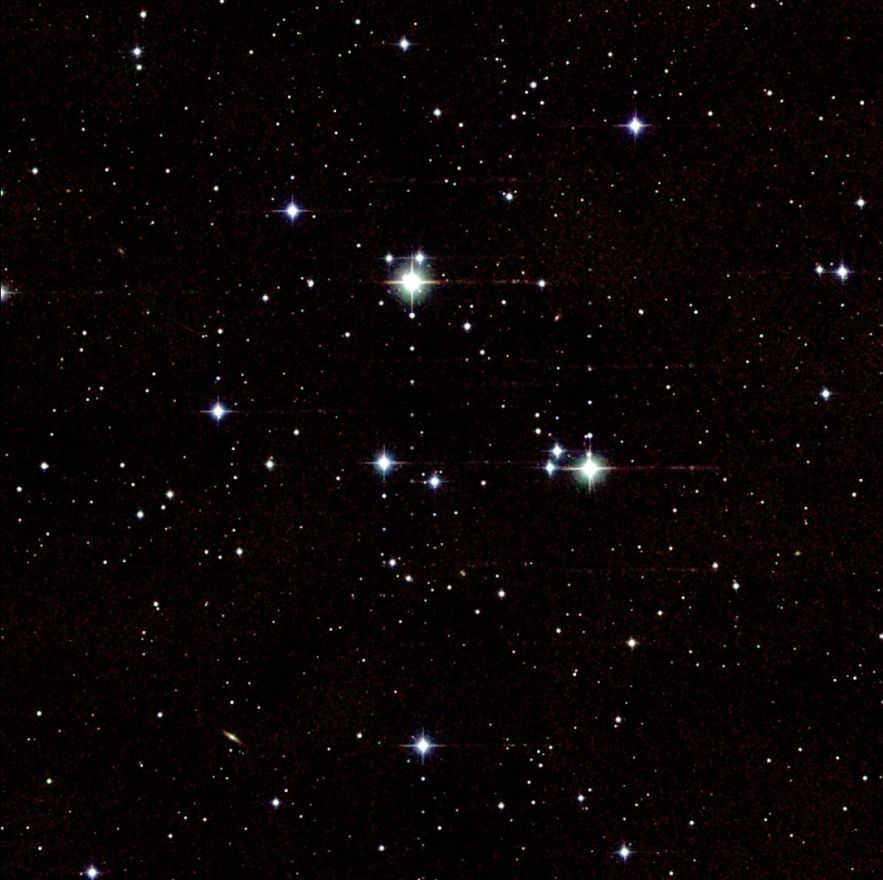
The Creche Cluster, also known as Messier 44, is a star cluster located in the constellation of Cancer. It is home to a diverse population of stars, with at least 1000 stars in its core. Among these, 63% are classified as red dwarfs, while 30% are categorized as solar-type F, G, and K-class stars. The brightest stars in the cluster have a blue-white color and fall within the magnitude range of 6 to 6.5.
One remarkable aspect of the Creche Cluster is its visibility without the need for additional equipment. This quality was recognized by Ptolemy, an ancient Greek astronomer, who referred to it as “the nebulous mass in the breast of Cancer”. The cluster was later observed by Galileo in 1609 through a telescope, and it was ultimately included in Charles Messier’s catalog in 1769.
Messier 67 (M67, NGC 2682) is one of the most ancient clusters ever found. It is estimated to be around 3.2-5 billion years old. Its magnitude is 6.1. It consists of over 100 stars similar to the Sun and a variety of red giants. Almost all of the stars in M67 are equidistant and have the same age, with the exception of approximately 30 blue stragglers. This unique characteristic has captured the attention of scientists, as it provides an opportunity to study stellar evolution. M67 was first discovered in 1779 by the German astronomer Johann Gottfried Köhler.
NGC 2775 (Caldwell-48) is a spiral galaxy located 55.5 million light-years away and has a magnitude of 3.11. It features multiple spiral arms adorned with H II regions, indicating recent star formation. The discovery of NGC 2775 can be credited to William Herschel in 1783.
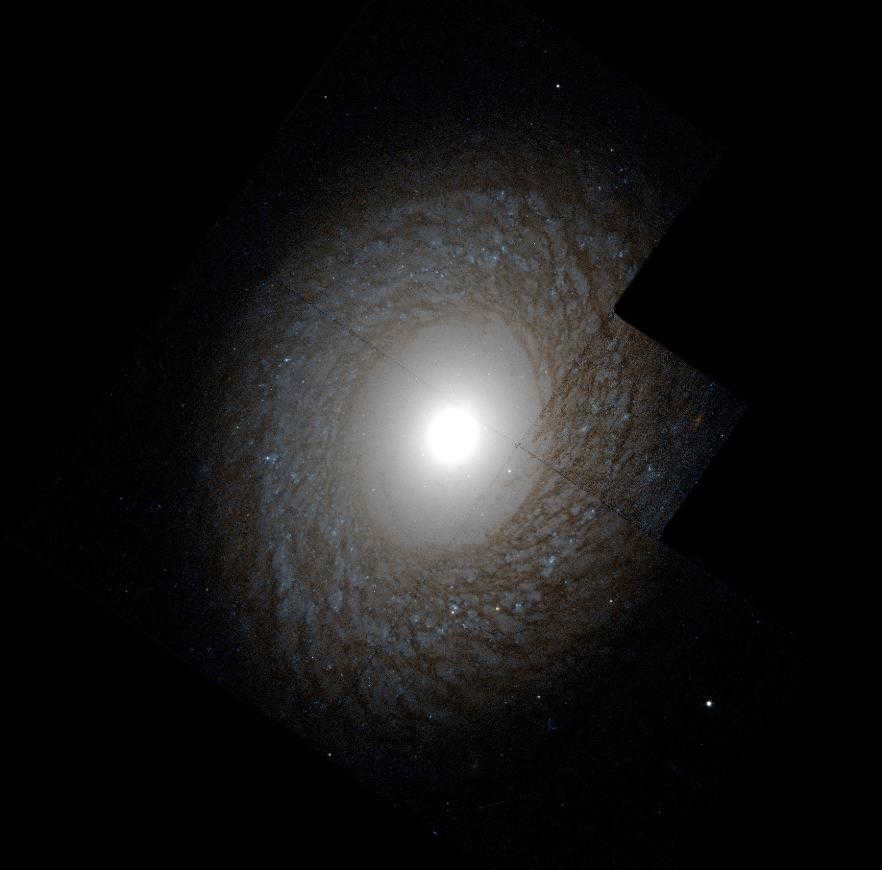
NGC 2535 and NGC 2536 are galaxies that are interacting with each other. NGC 2535 is a spiral galaxy that does not have a connection, and it has a visual magnitude of 9.16. On the other hand, NGC 2536 is also a spiral galaxy, but it does have a connection, and its magnitude is 6.14.
NGC 2500 is a spiral galaxy that is located 33 million light-years away, and it is known as a jumper galaxy. It has a magnitude of 12.2 and contains the H II nucleus. Frederick William Herschel discovered it in the late 18th century. NGC 2500 belongs to the group NGC 2841, which also includes NGC 2537, NGC 2541, and NGC 2552. These galaxies are located in the constellation Lynx.
NGC 2608 (Arp 12) is a spiral galaxy with a diameter of 62,000 light-years and a brightness of 1.13. It falls into the SB(s)b category, indicating that its spiral arms rotate around a central bar. NGC 2608 has a distinctive appearance and is located 93 million light-years away.
Recently, two supernovae were observed. In December 1920, SN 1920A reached a brightness of 11.7, while in May 2001, SN 2001bg reached a brightness of 13.7.
If you want to study the Cancer constellation in the northern hemisphere in more detail, we offer not only photos but also 3D models and an online telescope. You can also use a star map for your own exploration.
–Search by journal
–Get updates by email
–Data analysis
The Cancer constellation in the fields of astronomy, astrology, and folklore
We are continuing our exploration of constellations and zodiac signs. As of June 22nd, the Cancer constellation takes its place in the celestial sky.
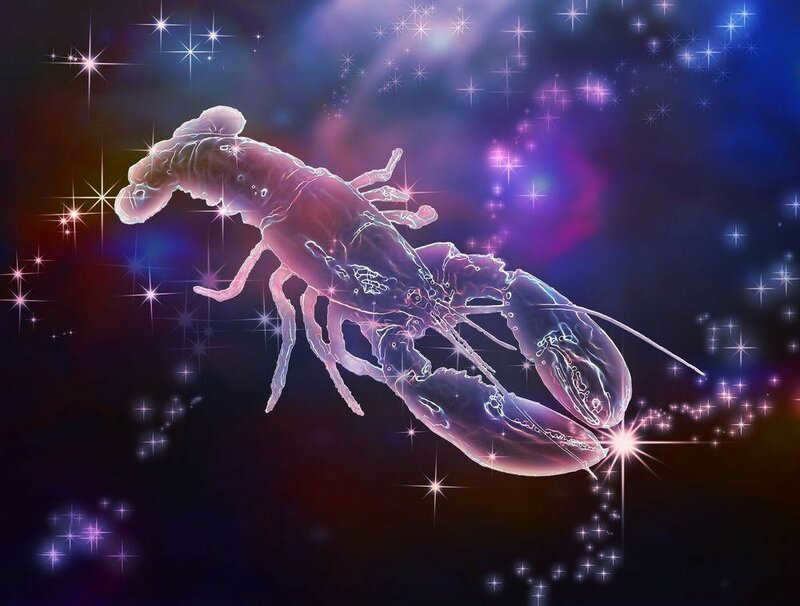
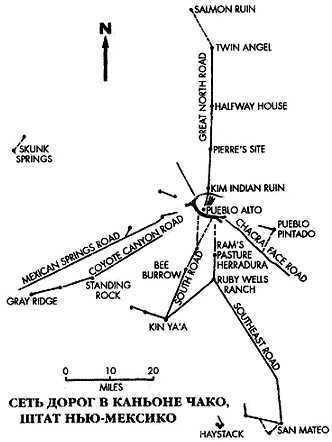
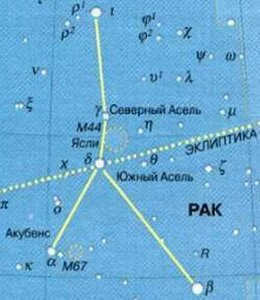
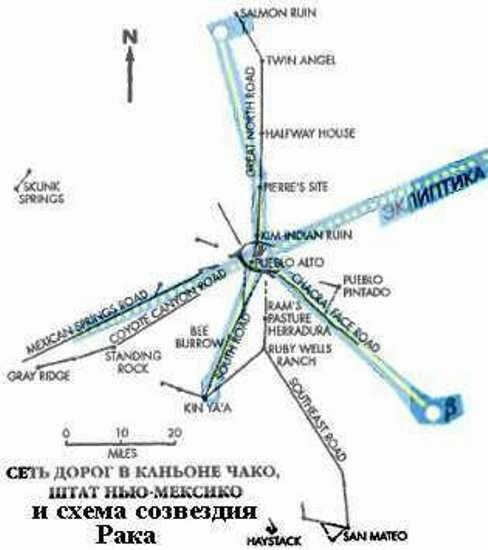
Therefore, the pueblo system in Chaco Canyon could potentially serve as a representation of the star constellation Cancer, often referred to as the “mirror of the heavens”.
So, let’s delve into the enigmatic nature of this celestial formation.
Cancer occupies a position within the second quadrant of the northern hemisphere (NQ2). It spans latitudes ranging from +90° to -60°. In terms of size, it covers an area of 506 square degrees, ranking 31st in magnitude.
Positioned between Leo and Gemini, the constellation Cancer is intersected by the ecliptic almost at its midpoint. The Sun traverses this cluster of stars from July 21 to August 9.
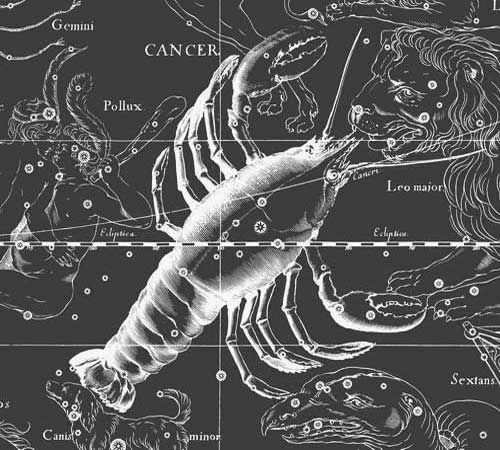
Cancer consists of well-known celestial entities, which include: the open clusters of Nursery (Messier 44), Messier 67, and the interacting spiral galaxies NGC 2535 and NGC 2536.
A star cluster is a collection of thousands of stars. They all have a similar age because they were formed from a single large interstellar cloud made up of molecular hydrogen. Other interstellar clouds contain ionized gas. These molecular clouds are commonly referred to as “stellar manger” clouds. Cancer’s nursery, M44, is also known as the Cluster Hive.
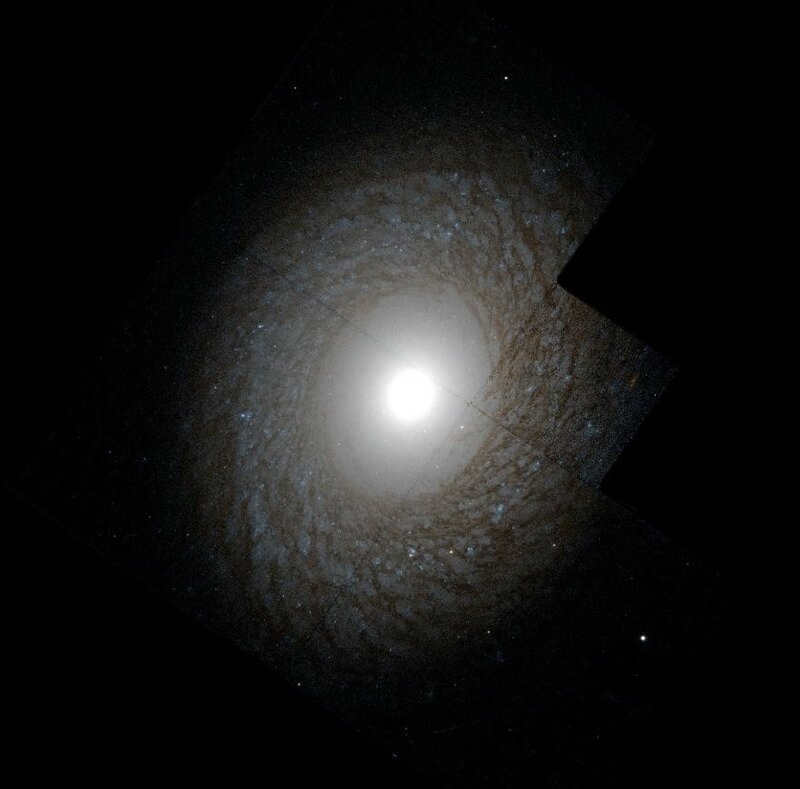
The core of the Cancer nursery contains a minimum of 1000 stars. Among them, 63% are red dwarfs, while 30% are stars of the F, G, and K classes, similar to our solar system. The brightest stars in this cluster have a blue-white color and magnitudes ranging from 6 to 6.5.
This cluster is visible to the naked eye, which is how it was initially discovered by Ptolemy, an ancient Greek astronomer. He referred to it as “the nebulous mass in the breast of Cancer.” Galileo observed it through his telescope in 1609, and Charles Messier later included it in his catalog in 1769.
Messier 67 (M67, NGC 2682) is one of the most ancient clusters ever found. It is estimated to be around 3.2-5 billion years old. The brightness of this cluster is measured to be 6.1. It is home to over 100 stars that resemble our Sun, as well as a variety of red giants. Nearly all of the stars in M67 are equidistant and approximately the same age, with the exception of around 30 blue stragglers. This aspect of M67 greatly intrigues scientists as it provides a unique opportunity to observe stellar evolution. The discovery of M67 is credited to German astronomer Johann Gottfried Köhler in 1779.
NGC 2775 (Caldwell-48) is a spiral galaxy located 55.5 million light-years away. It shines with a magnitude of 3.11. It exhibits several spiral arms adorned with regions of H II (hydrogen) that serve as active sites for star formation. The observation of these regions indicates that star formation in NGC 2775 has been ongoing relatively recently. The credit for the discovery of NGC 2775 goes to William Herschel in 1783.
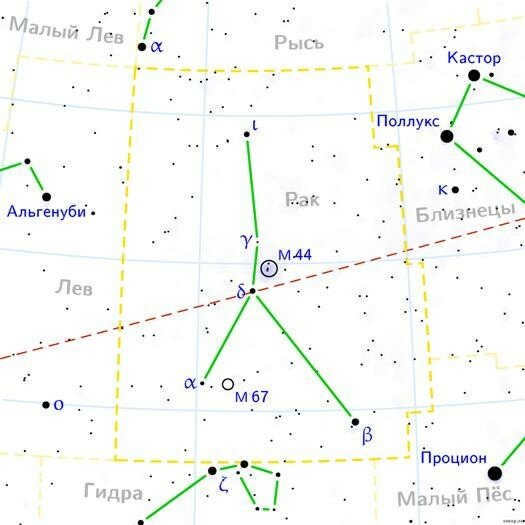
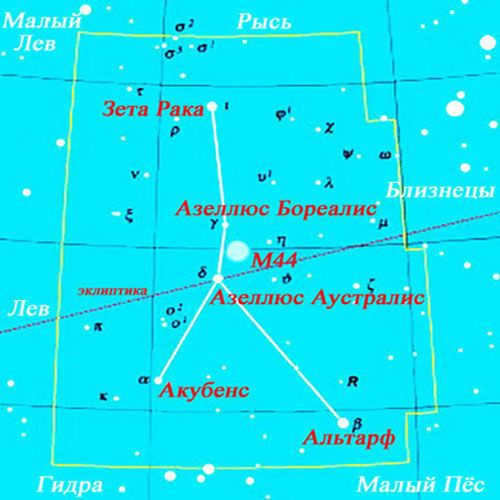
Beta Cancer is the most prominent star in the Cancer constellation. Another notable feature of the constellation is the Delta Cancrida meteor shower. Cancer is part of the zodiacal group, which also includes Aries, Taurus, Gemini, Leo, Virgo, Libra, Scorpio, Sagittarius, Capricorn, Aquarius, and Pisces.
The star Alpha Cancer, also known as Akubens in Arabic (meaning “claw”), is located approximately 174 light years away from Earth.
Delta Cancer is a giant orange star situated 180 light years away from our planet. Its Latin name, Azellus Australis, translates to “southern donkey”.
Zeta Cancer is comprised of four yellow-white stars and is located 83 light years away from Earth.
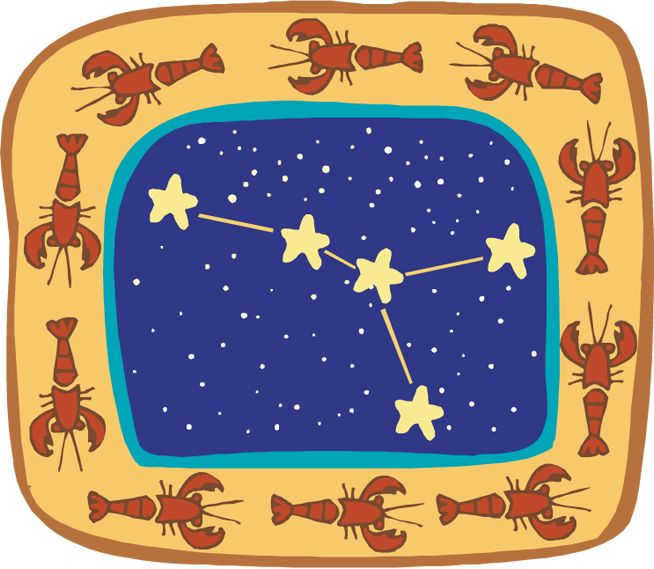
The legend surrounding this particular astrological sign recounts the tale of a colossal Crab that infamously nipped at Hercules’ leg during his epic battle with the nine-headed hydra of Lernaeus.
The fable goes that King Euryseus of Mycenae dispatched Heracles to confront a fearsome creature – a hydra which dwelled in a stream near the town of Lernae (Argolid) and terrorized both livestock and the local populace. Heracles enlisted the help of his nephew Iolaus in this daunting endeavor.
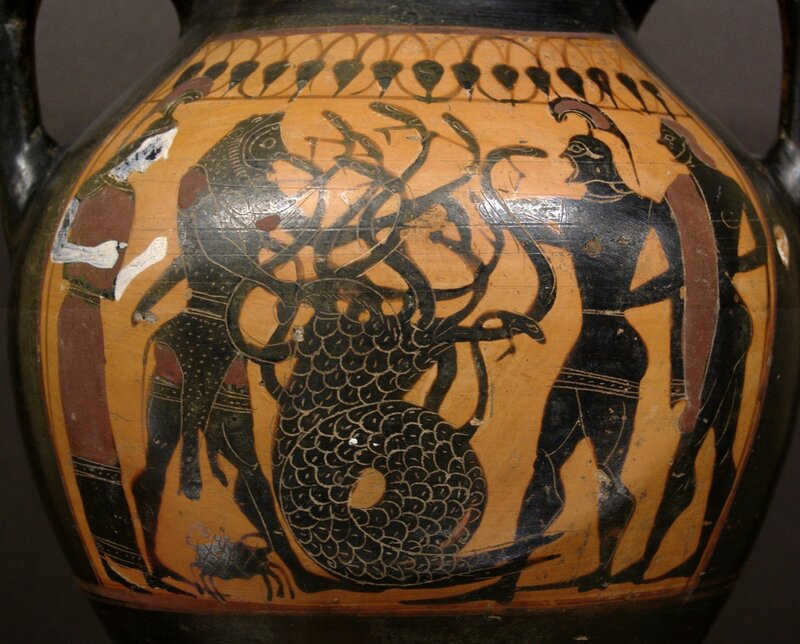
The courageous crayfish, or rather crab, can also be observed in the picture.
After learning that Heracles did not defeat the hydra alone, King Euryseus refused to give him credit for this accomplishment. As for Cancer and Hydra, their story took a very peculiar turn: the goddess Hera, who despised Heracles, immortalized both monsters by turning them into constellations in the night sky.
However, since Cancer ultimately failed in its task, Hera also punished them by placing them in a region with few bright stars (no more than magnitude 4).
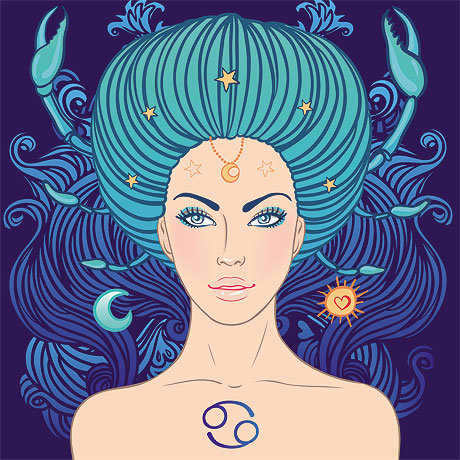
The constellation known as Cancer is classified as a zodiac sign and holds its own significance in sidereal astrology. Its designated time period differs from the actual time period. While the Sun traverses this cluster of stars from July 21 to August 9, individuals born between June 22 and July 22 are considered to be born under the Cancer sign. Whether one chooses to believe in astronomical predictions or not is a personal decision.
Meaning of the Name: Cancer, symbolized as a crab, represents traits such as backward movement, conservatism, tradition, home, and family.
Cancer Dates: June 22 – July 22
Sign Type: Water – Cardinal – Negative
Lucky Color: Orange, White
Individuals born under the astrological sign of Cancer, which is governed by the enigmatic Moon, are a fascinating enigma of the horoscope. It can be said with confidence that most Cancerians possess a multitude of perplexing contradictions. While they are deeply compassionate and nurturing towards their friends, family, and loved ones, their penchant for making jealous remarks and their seemingly endless whims can easily unnerve others.
Similar to the Moon’s ever-changing phases, Cancerians themselves undergo various stages of transformation throughout their lives, accumulating valuable experiences and knowledge. The journey of this zodiac sign never ceases, even if Cancerians remain physically stationary, as they reside in their own realm, immersed in a sea of internal emotions.
With their deep connection to the Moon, they often find it challenging to adapt to the ever-changing world around them. Their reality can shift dramatically in a matter of seconds, making their lives feel like a thrilling roller coaster ride. They have no choice but to embrace the present moment, and this unique quality only adds to their enchanting charm.
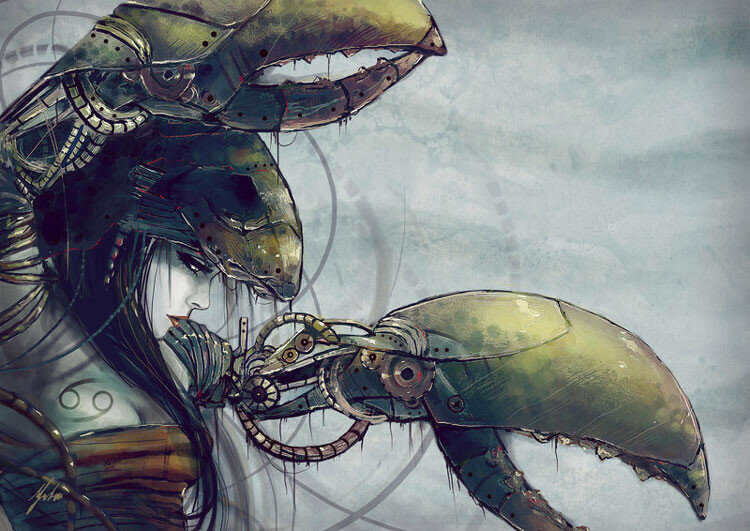
With a captivating quirkiness, Cancers possess a deep concern for their image in society and how they are perceived by others. While they may project a tough and unfeeling exterior, akin to their astrological symbol, beneath lies a tender, sensitive, and affectionate being. It is important to remember that all Cancerians are under the influence of the Moon, the celestial protector of all romantics.
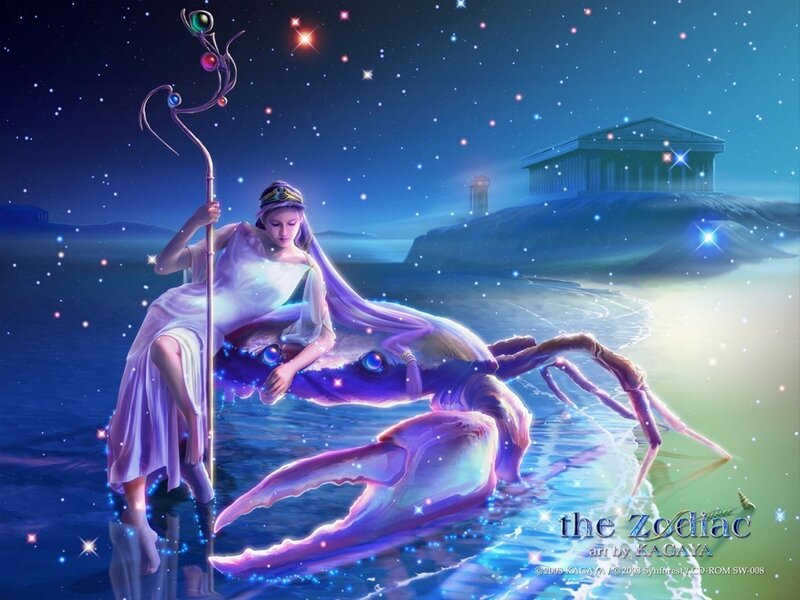
Individuals born under the Cancer zodiac sign have their true essence unveiled in the gentle glow of the moon, a perfect reflection of their ever-changing emotions.

Today, let’s discuss the least noticeable part of the sky in the north. It is none other than the Cancer constellation. While it may not stand out, it holds significance as one of the zodiac constellations, carrying its own importance in the vastness of space and human existence.
Despite its reputation as a dim and unremarkable constellation, Cancer actually occupies the 31st spot in terms of size, covering a vast area of 506 square degrees. Furthermore, it shares borders with numerous well-known regions of the Northern Hemisphere’s sky.
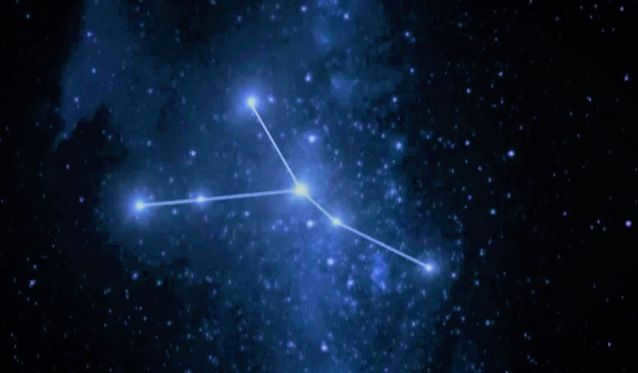
Mythology surrounding the constellation Cancer
As per the ancient Greek legend, Heracles achieved victory over the fearsome Hydra, one of his twelve labors. During the intense battle, Hera, the goddess of marriage and birth, dispatched a crayfish to distract the valiant hero. Intriguingly, there exist two versions regarding the outcome of this encounter. In one version, Heracles managed to push the crayfish back into the heavens. Conversely, another rendition states that he trampled upon it. However, Hera expressed gratitude towards the creature by immortalizing it in the night sky, thus giving birth to the constellation Cancer.
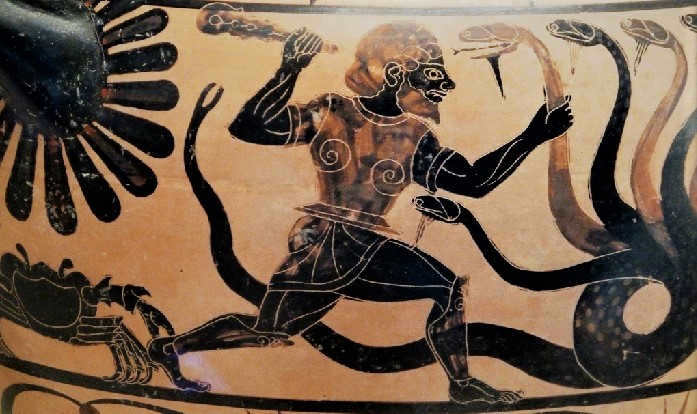
The primary celestial bodies
The star Alpha is famously recognized as Acubens, which is a complex system of stars. Despite being the 4th most luminous star in the constellation, it is also commonly referred to as the claw or the crab.
Beta is a binary star system known as Altarf. It consists of an orange giant and its companion star. Interestingly, it is the most radiant celestial object within this constellation. It is also alternatively called the eye or the gaze of the Lion.
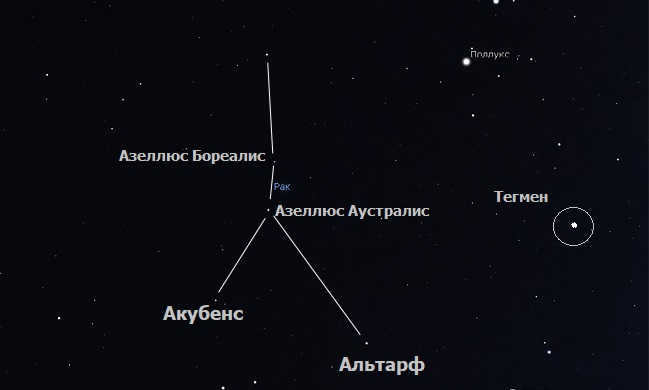
Delta is known as Azellus australis. It belongs to the group of orange giants and is the second brightest star. Delta has the longest name, which means southeastern star. However, it is often referred to as the Southern Donkey.
Gamma is a white subgiant known as Azellus borealis. It has been given the nickname of the Northern Donkey.
55 Cancer is a binary system consisting of yellow and red dwarfs.
Zeta is a multiple system called Tegmen. Scientists believe that it is made up of four stars. The entire structure is referred to as the crab’s shell.
Lambda is a blue-white dwarf star in the main sequence.
Xi is a paired star and a spectroscopic object. It consists of a yellow giant and its companion.
Additional items
The Cancer constellation encompasses a number of dispersed star clusters:
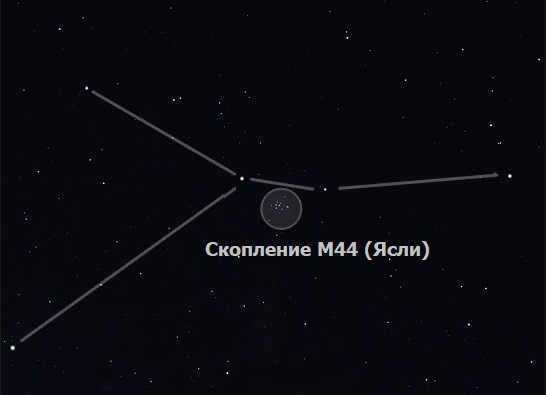

- The Nursery (M 44), also known as the Beehive, is composed of approximately 200 stars. Interestingly, it is one of the nearest clusters to Earth and therefore can be easily observed in the night sky.
- M 67 contains around 500 celestial objects and is noteworthy for being the oldest known star cluster.
- NGC 2664 and NGC 2678 are two star clusters that have received less attention in scientific research. However, ongoing studies are being conducted to explore their characteristics and properties.
Incidentally, there are several examples of spiral galaxies. Take for instance, NGC 2535 and NGC 2536. They have an interaction with each other.
Furthermore, there exists a galaxy called NGC 2775 with numerous arms. Alternatively, there are star systems that possess a junction. These encompass the galaxies NGC 2500 and NGC 2608.
On top of all these, the area is also a habitat for a meteor shower known as Cancrida Delta.
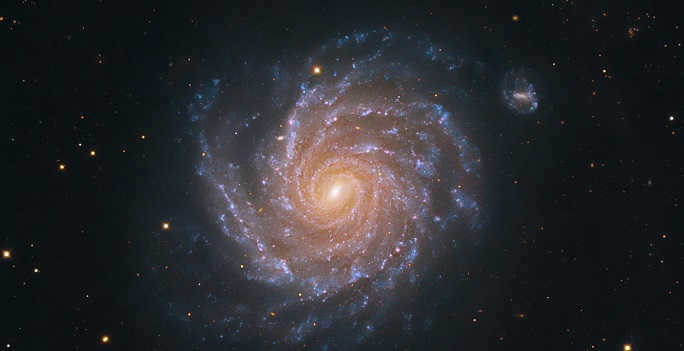
Constellation of Cancer
The constellation of Cancer is made up of the stars Gamma, Delta, and the M 44 cluster. These two stars are commonly known as the Donkeys, which is why the asterism is named as such.
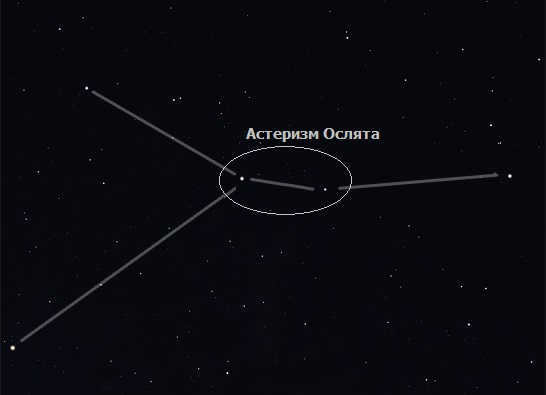
Curious details about the Cancer constellation
Without a doubt, the region in question serves as a captivating subject for exploration. While it may not stand out prominently in the night sky, it possesses its own unique charm and allure. To illustrate, here are several intriguing tidbits about this constellation:

- Water is believed to be symbolized by the Cancer constellation.
- Additionally, the Cancer constellation is commonly known as the crab.
- The Tropic of Cancer is the Earth’s northern tropic, which was once the location of the summer solstice two thousand years ago.
- Ptolemy included it in the star catalog.
- Astronomers have discovered five planets orbiting 55 stars of Cancer to date. Interestingly, there are only four such planetary systems in the entire universe.
Observation
To locate the constellation Cancer, one should search within the latitudes ranging from +900 to -600. Astronomers suggest that finding this area is not a difficult task, but it can only be observed on a clear night.
It is commonly believed that the best time to observe Cancer is towards the end of winter. From any point in Russia, one can observe the Crab constellation.
Among the 47 oldest constellations still present in the starry sky, Cancer holds a place. These constellations were formed over several centuries and were documented by Claudius Ptolemy, an Alexandrian astronomer, around 150 AD. His Almagest treatise served as a comprehensive source of information for astronomers for 1500 years.
Where can it be found?
Locating the constellation of Cancer (also known as the Crab) in the night sky can be quite a challenge. With no prominent stars, it is not easily visible. This task becomes even more challenging in urban areas due to light pollution and the hazy sky caused by city lights.
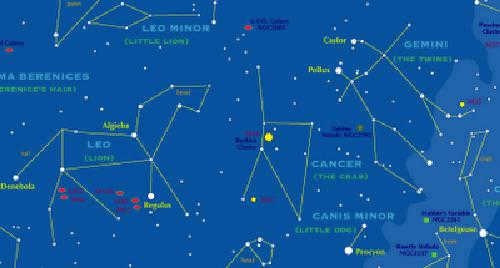
During the winter and early spring seasons, when the night sky is clear, you can easily spot two prominent constellations by looking towards the south. These constellations, Leo and Gemini, are characterized by their bright stars and unique patterns. Positioned between these two constellations is Cancer, which forms an inverted letter Y shape. Cancer constellation is particularly visible in Russia. It is worth noting that the Sun enters this constellation on July 20th.
What star were you born under? The sky is filled with countless celestial bodies. In order to differentiate them, people started naming constellations. Throughout the year, the Earth orbits the Sun and passes through all twelve constellations, just like the twelve months of the year. Each zodiac sign is associated with a unique character trait.
Unique Traits of Individuals Born Under the Cancer Zodiac Sign
Individuals born under the Cancer zodiac sign exhibit a remarkable level of sensitivity. They have the ability to be deeply affected by even the slightest unkind word, often spiraling into a state of depression. However, it is important to note that Cancer individuals possess a strong internal energy, which allows them to effortlessly transfer their negative mood to those around them. Despite their predisposition to melancholy, Cancer individuals also possess a fondness for laughter and are blessed with a great sense of humor.
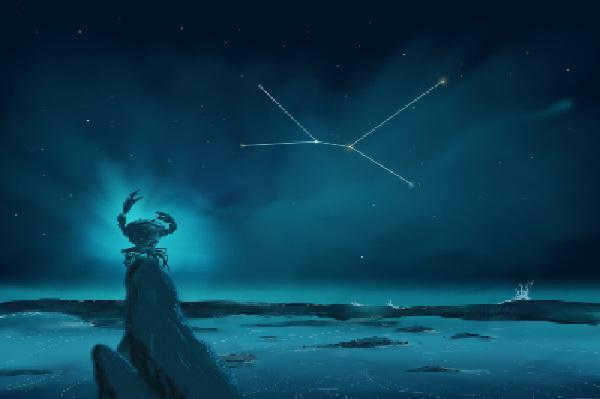
The Cancer individual’s existence is characterized by a series of highs and lows, yet even when circumstances are in their favor, they will withdraw and seize the opportunity to rest during a lull. Instead of using pressure and aggression, Cancer prefers to employ cunning and weariness.
They have a preference for a tranquil family life. They are generous with their loved ones and close friends, but frugal with strangers. This applies not only to their finances, but also to the expression of their emotions.
Origin of the Name
Around two thousand years ago, during the establishment of astronomical terminology, the Tropic of Cancer received its name. This point on Earth, which coincided with the position of the Sun during the summer solstice, marked the northernmost point where the Sun appeared directly overhead. As the Sun moved further north, the duration of daylight decreased. In modern times, this point has shifted to the constellation of Taurus.
The ancient Egyptians believed that the Tropic of Cancer symbolized death and destruction. They associated it with the image of a cancer, which feeds on carrion and advances with its tail.
In ancient Greek mythology, Cancer (constellation) corresponds to the crayfish involved in one of Hercules’ great feats. During the battle with the formidable Lernaean hydra, all the creatures stood by Heracles except for the crayfish, which boldly leaped out of the marsh and clutched onto the hero’s leg. Unfortunately, this act of bravery proved fatal, as the crayfish was swiftly crushed. To show her appreciation, Hera, the wife of Zeus and a strong detractor of Heracles, transformed Cancer into a constellation. Today, Cancer (constellation) holds a prominent position in the renowned zodiac circle (Egyptian) displayed at the Louvre.
Crèche and Donkey
The two main celestial bodies in the constellation, Gamma and Delta, are known as Donkeys. They were positioned in the heavens by Dionysus, the youngest “Olympian” god who presides over winemaking. These donkeys hold a significant place in Dionysus’ worship and are considered his sacred animals. However, there were additional factors that led to their inclusion in the constellation. Let us delve into the events that transpired.

Hera, consumed by jealousy, harbored a deep hatred for her husband’s lovers and their illegitimate offspring. Her animosity towards Dionysus drove her to transform him into a deranged individual. Desperate for a solution, Dionysus sought guidance from his father Zeus’ oracle in Dodona. The priests advised him to seek the wisdom of a sacred oak tree, whose rustling leaves held the key to restoring his sanity. Unfortunately, a vast swamp obstructed his path. However, two donkeys happened to be grazing nearby, and with their help, Dionysus managed to navigate the treacherous terrain. In gratitude, Dionysus immortalized both donkeys by transforming them into constellations in the night sky.
Close to the Donkeys, you can find a cluster of stars known as the Crèche Nebula. According to mythology, it is said that the god Dionysus himself looked after the animals in this area and even left a bundle of hay for them to eat.
Originally, the constellation was called the “Donkey’s Manger” before it was officially named “Cancer”. It was only around 430 AD that the name was changed to its current form. This change is believed to have been influenced by the Greek astronomer Euktemon.
Stars in the Cancer Constellation
The most prominent star in the Cancer constellation is Altarf (beta Cancer), which has an apparent magnitude of 3.52 (the lower the number, the brighter the star). Altarf is classified as an orange giant and is 50 times larger than our Sun. Akubens (alpha of Cancer), which means “claw” in Arabic, is a white star. The star Zeta Cancer is a fascinating system with two orbiting components that complete a revolution in approximately 60 years, while a third component orbits around these two elements every 1150 years.
